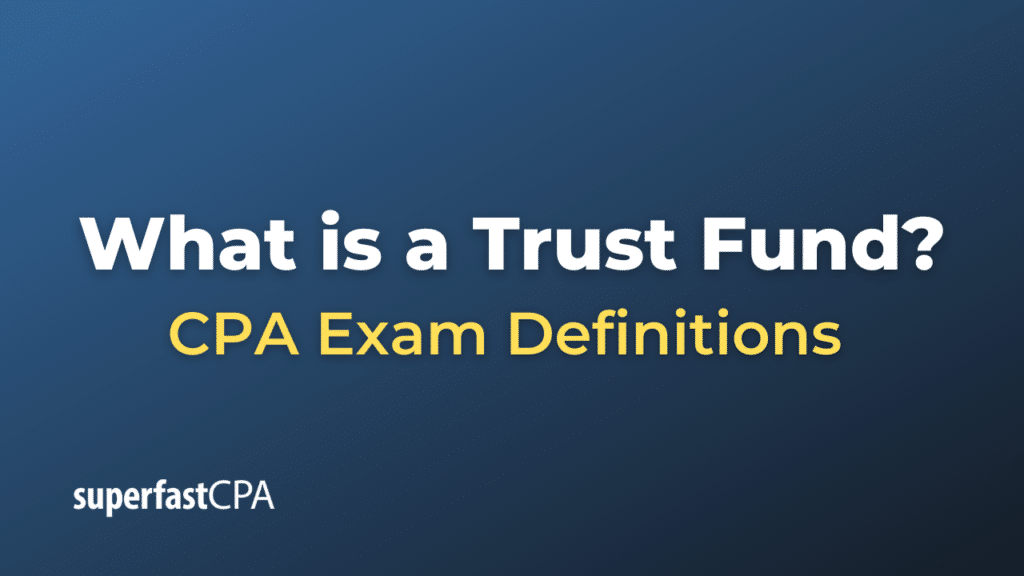Trust Fund
A trust fund is a legal entity established to hold and manage assets on behalf of certain beneficiaries under the guidance of a set of terms and conditions. These assets can include money, stocks, real estate, or other valuable properties. The person who creates the trust is known as the “settlor” or “grantor,” and they transfer the legal title of the assets to the trust.
Key elements and players in a trust fund are:
- Settlor (or Grantor): The individual or entity who establishes the trust and funds it with assets.
- Trustee : A person, institution, or entity responsible for managing the assets in the trust, making distributions, and ensuring the trust’s terms are followed. A trustee has a fiduciary duty to act in the best interests of the beneficiaries.
- Beneficiary: The individual or entity that will receive the benefits from the trust, as designated by the grantor. There can be multiple beneficiaries, and they can have different levels of benefits depending on the trust’s terms.
- Terms of the Trust: Outlined in the trust agreement, these specify how the trust assets are to be managed, distributed, or utilized, and under what circumstances.
There are different types of trust funds, including:
- Revocable Trust: This allows the grantor to modify or dissolve the trust during their lifetime. It becomes irrevocable upon the grantor’s death.
- Irrevocable Trust: Once established, the terms of this trust generally cannot be modified, amended, or terminated without the permission of the grantor’s named beneficiary or beneficiaries.
- Living Trust: Established while the grantor is alive. It can be either revocable or irrevocable.
- Testamentary Trust: Created as part of a will and becomes effective upon the grantor’s death.
- Charitable Trust: Established to benefit a particular charity or the public in general.
- Special Needs Trust: Designed to benefit individuals who have physical or mental disabilities.
- Spendthrift Trust: Established to protect the trust’s assets from the beneficiary’s creditors or to ensure that the beneficiary does not squander their inheritance.
The primary purposes of setting up a trust fund include:
- Asset protection against creditors.
- Reduction of estate tax liability.
- Controlled distribution of wealth over time.
- Ensuring funds are available for specific purposes, such as education or charity.
- Management of assets in case of incapacity or absence.
Trust funds are complex structures, often requiring the expertise of lawyers, accountants, and financial advisors for proper setup and management.
Example of a Trust Fund
Let’s dive into a hypothetical example to better understand the concept of a trust fund.
Scenario:
Mrs. Eleanor Wright, a successful businesswoman, wants to ensure that her accumulated wealth provides for her three grandchildren’s college education. However, she’s concerned that if she just gives the money directly, it might be spent irresponsibly. To manage this, she decides to set up a trust fund.
Key Elements:
- Settlor (Grantor): Mrs. Eleanor Wright
- Trustee: Eleanor chooses a reputable bank’s trust department to act as the trustee. This bank will manage the assets, invest the funds, and make distributions as specified in the trust’s terms.
- Beneficiaries: Eleanor’s three grandchildren – Adam, Bella, and Charlie.
- Terms of the Trust: The trust fund’s assets will be used exclusively for covering tuition, accommodation, and related college expenses for the beneficiaries. Each grandchild can draw from the trust starting at age 18, but only for educational purposes. If any funds remain after all the beneficiaries have completed their education, they can access the remaining funds when they reach 25 years of age for any purpose.
Setup:
Eleanor transfers $900,000 into the trust. The funds are to be invested conservatively by the bank, aiming for modest growth over time.
How It Plays Out:
- Adam, the eldest, begins college at 18. The trustee pays Adam’s tuition and related fees directly to the university from the trust fund. Adam’s total college expenses over four years come to $200,000.
- Bella decides to study abroad. Given the higher fees and living expenses, her total educational costs over four years amount to $250,000, which is again covered by the trust.
- Charlie opts for a six-year medical program, and his expenses come to $300,000.
By the time all three beneficiaries finish their education, the trust fund has paid out $750,000. With growth from investments, let’s assume the trust has $200,000 left when Charlie finishes his studies.
Upon reaching the age of 25, the three grandchildren will have equal rights to the remaining amount, which means each will get approximately $66,666.
This example illustrates how a trust fund allows Mrs. Eleanor Wright to ensure her wealth is used in a specific manner, offering controlled financial support to her grandchildren’s education while protecting the funds from potential misuse.













